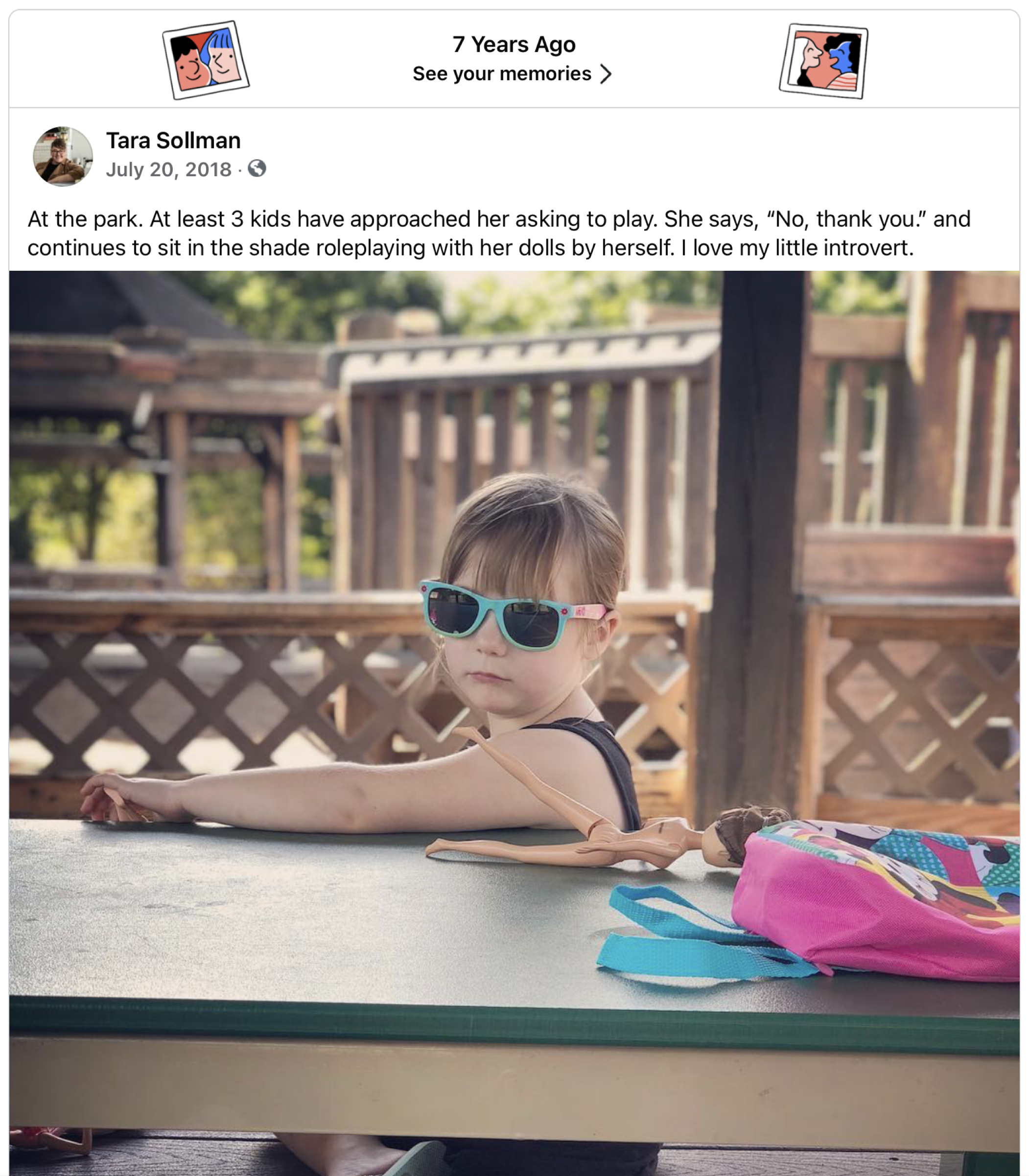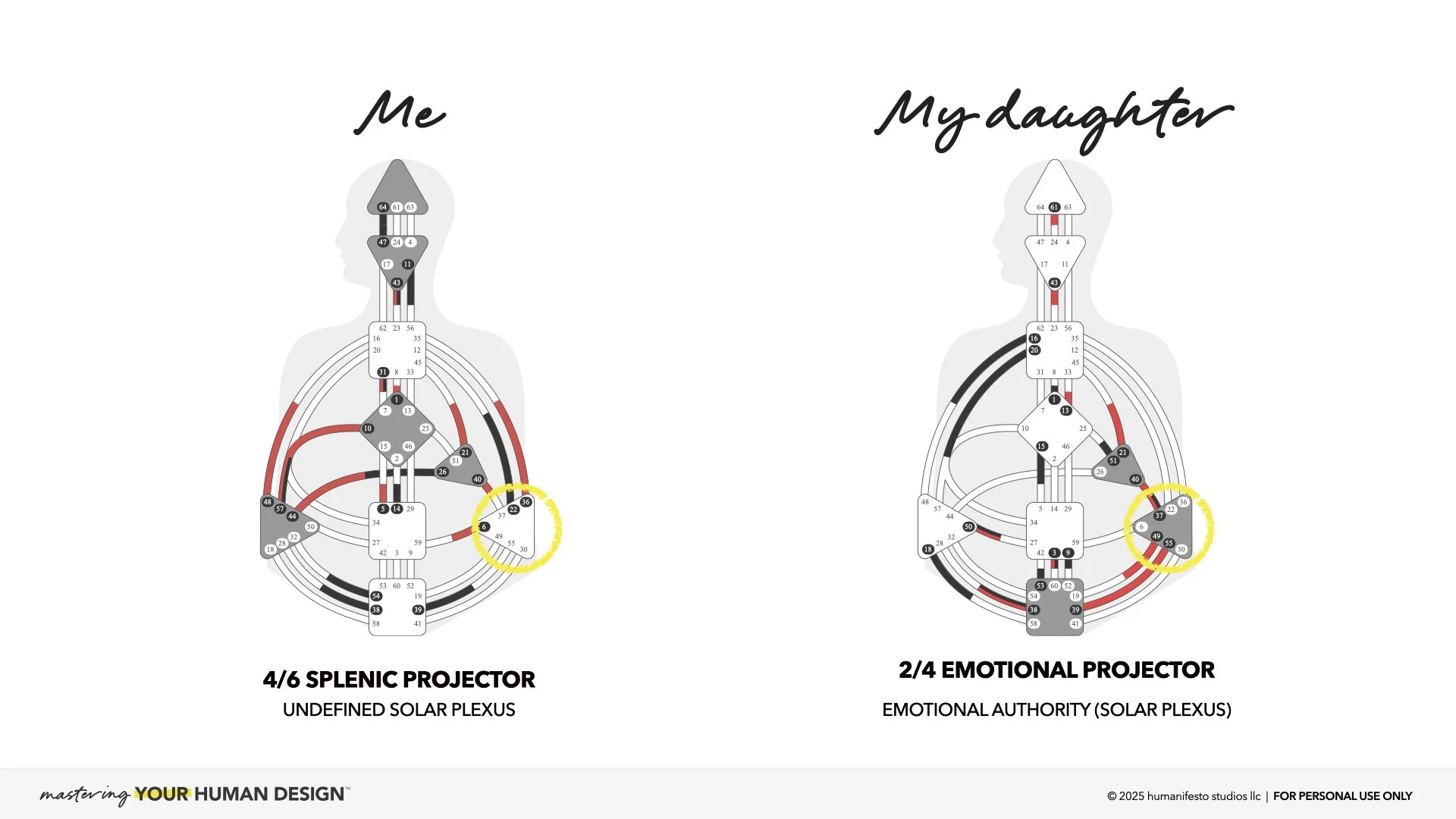How my daughter teaches me to stop people-pleasing
On Sunday this photo ☝🏻 came up in my Facebook memories. My daughter Livy sitting at a picnic table, lookedly decidedly unbothered. The caption reads: At the park. At least 3 kids have approached her asking to play. She says, “No, thank you.” and continues to sit in the shade roleplaying with her dolls by herself. I love my little introvert.
When I shared that seven years ago I knew nothing about Human Design. But I was noticing.
Noticing that my daughter didn’t have the “people pleaser” gene that I seemed to be cursed with. That it was easy for her to let others down gently without feeling the need to fix or force them to feel a certain way about her boundaries.
She has been teaching a masterclass on what aligned, emotional authority looks like. And I am the eager student sitting in the front row.
My bodygraph chart showing my undefined solar plexus, compared to my daughter’s chart showing her defined solar plexus which operates as her decision-making authority(called emotional authority)
Like 47% of the population, I have an undefined solar plexus. This makes me highly sensitive to other people’s emotions — I can easily feel what others are feeling sometimes even more intensely than they do. Often it’s hard to tell which feelings are even mine, and which aren’t.
In therapy terms, this is often called people-pleasing or even co-dependence. Until I met Human Design I used those terms freely to describe myself and even spent time in the rooms of Co-Dependents Anonymous thinking of my people-pleasing as an addiction that I needed to recover from.
In Human Design terms, my undefined solar plexus made me vulnerable to conditioning which meant a lifetime of constantly trying to keep the peace or control how everyone else is feeling.
My daughter came here with emotional authority (the term for one whose decision-making authority resides in their solar plexus) — my perfect teacher for what it looks like to not fix, force, or figure it out for others.
Her job is to honor her strategy and authority. My job is to refrain from conditioning her to abandon herself in favor of contorting herself to be like others.
Please believe me when I tell you that this is NOT easy work. On an almost daily basis I am triggered by her refusal to people-please. (It’s not even really a refusal for her, she just wasn’t built to do it.)
Just a few weeks ago she was at the kitchen table playing The Game of Life, that board game where you drive a little car around the board and make life choices in order to succeed. It’s a current favorite of hers, and she was playing with some elder members of our family and having a great time. Then all of a sudden, she got teary-eyed and wanted to quit. I asked her why and she couldn’t explain to me why. In that moment I felt a STRONG urge to force her to finish the game. This is what that sounded like in my mind:
“It’s rude to quit in the middle of the game.”
“As a parent I need to teach her that we don’t quit things, especially not group games.”
“The feelings and perceptions of others at the table matter, and I want to look like a good parent who has compliant, dutiful, and kind children.”
Instead of forcing her to continue the game, I decided to let her quit. She left the table and spent some time on the couch in the other room — voluntarily watching from a distance — while I took her place in the game. Eventually, she came back to the table and laughed along with us as we finished the game. I still don’t know why she felt the need to quit, and it doesn’t matter.
The emotional wave is felt in the body.
I don’t need her to put it into words if she can’t.
I like to think of the undefined centers on our chart as being the ways we are here to “go to school” in this lifetime. The ways our souls are here to evolve, grow, and explore. What I’m learning about my undefined solar plexus is that it’s okay to feel uncomfortable emotions and that I don’t have to fix or absorb what isn’t mine. The more I get that, the more wise I become — an observer of emotions, with a deep understanding of how feelings move through people.
Note: Every Human Design chart is more than the sum of its parts, and every element of a chart affects — and is affected by — every other element. Human Design is a deeply layered, complex system that integrates eastern and western traditions and wisdom. When I share discrete elements of a chart, I am simply sharing glimpses into the mechanics of Human Design (and the Gene Keys) to show others how they, too, can discern practical insights from their own charts into their uniqueness and the patterns of thought, behavior, conditioning, emotions, and psychology that keep them from achieving their highest potential or living their best life.
Find out what 46,760,180+ fellow humans know that you don't.
✔️ Download your free Human Design chart to get started on your Human Design adventure
✔️ Join our private and supportive weekly coaching circle
✔️ Subscribe to receive offers, invitations, and periodic tips to help you learn and live your unique Human Design


